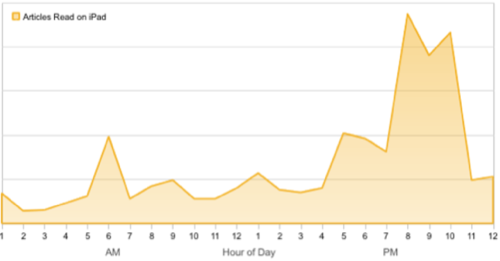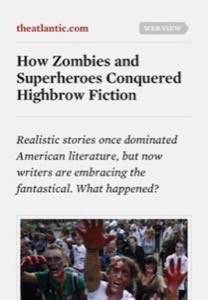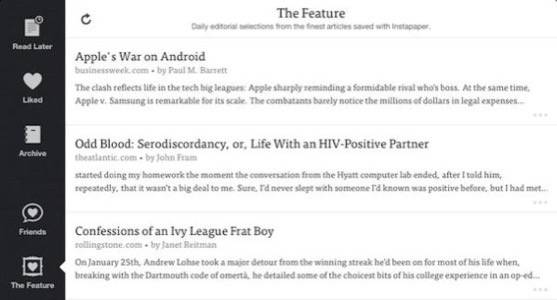
We don’t know where Web publishing is going yet, but we do know this: People want control over where and when they do their reading. The Read It Later blog published convincing proof of that over a year ago, and many an iPad has sold since then. It’s all about the tablet, especially in conjunction with the smartphone.

The future publishing business is literally in consumers’ hands, and they won’t give it back. We’ve tried paywalls and consumer surveys. We’ve ruined our websites with ads for unexciting native apps. We’ll even try to fix advertising. But let’s face it: The only future that works will be the one consumers want.

What the People Want
It seems they want a future where they can strip out everything but the stuff they want – especially ads – and save it for later. This is still in the early-adopter phase, but there’s a soaring market for apps that provide this service.
Ad blocking used to be an edge case. Nerds with Firefox were never going to pay you anyway. Just write them off. But now it’s available for anywhere from $5 to free in the local App Store, and it’s selling like… well, iPads.
These apps walk a fine line. If they threaten publishers’ fragile businesses, that industry spooks easily. It will find some awful way to block content from being saved for later, and everyone will be worse off.
Different Approaches
Marco Arment, creator of Instapaper, has always been cautious. While his competitor, Read It Later, took the liberty of condensing multipage articles into a single page when saved, Instapaper did not. This is a common (read: awful) trick sites use to garner maximum page views, and everybody hates it. Read It Later was doing a service for its customers, but it risked spooking the publishers.
Now there’s a new game in town. Readability was always a weird service. It provided cleaned-up Web views of articles, and in order to get the full-fledged service, it asked users to subscribe for a small monthly fee. Readability would collect money on publishers’ behalf, and if they signed up, that money would be distributed to them proportionate to the number of articles saved in Readability.

This was presumptuous. It sought to impose a business model on Web publishing and said “We’ve got your money. If you want it, sign up.” Some publishers didn’t take kindly to that.
Readability recently launched its iOS and Android apps, and its naive stance toward the publishing industry has only been bolstered. In November, when it announced the iOS apps, Readability made the service free, giving it a chance to scale up to threaten the other established apps, and it made the subscription optional.
The Middleman
How’s that going? Not well at all. Ben Brooks, an independent tech writer who is pretty much the ideal Readability publisher, reports that Readability revenues have plummeted since the app went free.
But that’s a long-term problem. It’s still worth trying the experiment. The more immediate problem is that Readability plays fast and loose with its links. A few weeks ago, I discovered that links shared from Readability go straight to the Readability view on the iPad. It doesn’t load the original page at all.
I’m not moaning about page views here. That’s not my point. I’m a blogger, but I don’t care about blogging nearly as much as I care about reading and sharing.
The problem with this is that it breaks sharing. It forces mobile users to use Readability instead of their link-saving app of choice, which might be Instapaper, a service that does treat publishers with more distance and respect. It might be Pinboard or another bookmarking service. A shared link should always, always, always be the original URL, so that users can do with it as they please.
Instead, Readability skipped ads for publishers and showed ads for itself instead. Even on the desktop, though it loads the original page below, it puts the linked story in a Readability.com frame, so the URL still isn’t right.
Embattled Readability CTO Chris Dary said he and the team would think more about “mobilized” views, which apparently include tablets. In response to a complaint on AppAdvice today, Readability decided to do the right thing and share real links in the meantime, while it “come[s] up with something more graceful for both the user and the publisher.”

Creating Value vs. Siphoning It Off
The future of publishing is up to the customer. No other service should interpose itself. The margins of this business are thin enough.
Instapaper does not do this, and Arment is clear about why. He creates a new kind of value for consumers by giving them a place to save things they want to read and share them later. Publisher page views are preserved more carefully, and shared stories link to the publisher’s site.
Readability has taken some brash actions. It’s good of the company to reconsider at least some of its unwelcome innovations. Remember what happened to Zite? No? Exactly.
UPDATE 2:01 p.m.: Readability has posted a statement on its blog to re-frame its goals and motivations:
“We take pride in being the first reading platform to try something this radical. Is our method of paying publishers the right one? Almost certainly not yet. if you’re a publisher and are uncomfortable for any reason, contact us and we’ll fix the issue.
“We’re experimenting because we do not believe that, ten years from now, advertisers will be happily paying for CPM banner ads on a site that people leave to read in some other app. And we don’t believe that publishers will support over the long term paid apps which generate no revenue for the publisher. The model we’re experimenting with definitely has its challenges, and we’re going to be careful about how we handle change because we made a public promise by way of our model.”
As I said, it’s worth trying the experiment. But Readability interjecting itself too forcefully without a sure bet for publishers and consumers could sour the milk for everyone. All these services result in some lost ad revenues. At least Instapaper avoids causing that where possible. Publishers have to compete with the experience of read-later apps if they don’t want to lose that revenue. But Readability needs to put publishers and readers ahead of itself if it doesn’t want its experiment to backfire.
Lead image courtesy of Shutterstock










